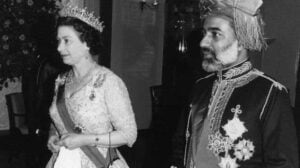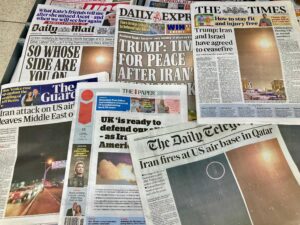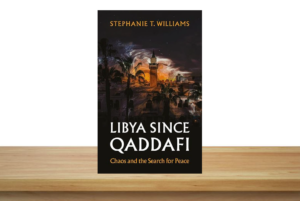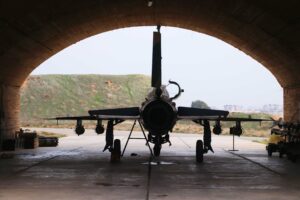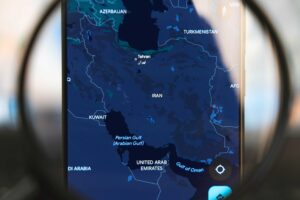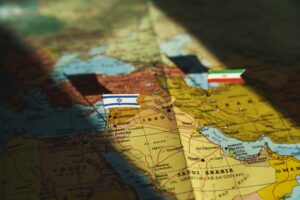This article is part of a multi-part series on Arab Gulf security.
In 1970, the complexities of transforming Oman from a dependent relic of almost three centuries of British trade and colonial policies into an independent state ruled by an Omani sultan was, to put it mildly, a daunting task. The ability to promote the “façade of independence” was simply no longer possible.[i] The alternatives were sobering. Desperate for the financial windfall of British oil leases in the Gulf, London could not afford to allow Oman to go the way of South Yemen, a turn of events that would have had ramifications for not only Oman but also for Abu Dhabi and the rest of the Gulf. Having just “withdrawn from the Gulf”, Britain was in no position to impose its will in Oman or anywhere else for that matter – that is, not without help. On the one hand, the leftist regime in South Yemen and its support for the Popular Front for the Liberation of Oman and the Arabian Gulf (PFLOAG) spelled trouble for Oman, but on the other hand, it presented an opportunity to enlist support. In addition to British interests, a collapse in Oman threatened US interests and those of its allies: Jordan, Saudi Arabia, and Iran. Help was to be had but the British needed a Sultan who projected competence and engendered confidence among potential allies. In this case, if nothing else, fortune smiled on a diminished Albion and Al Bu Said.
Sultan Qaboos and the Sultanate of Oman
In fairness, Sultan Qaboos bin Said Al Bu Said came to the throne with advantages that were not afforded to his father, whose ascension in 1932 had been welcomed by the British. Qaboos was not only intelligent but also shrewd in his political calculations. He was British educated, having graduated from the Royal Military Academy at Sandhurst, and served with the British Army in West Germany. He was progressive and open to new ideas and approaches to governance particularly regarding integrating a basically tribal society within a functioning modern state structure. Qaboos understood the nexus between stability and economic development. Critically important, he personally embodied the Omani state. He was the only son of Sultan Said and his mother, Mazoon al-Mashani, who was the daughter of the principal sheikh of the al-Mashani tribe and a jabali from the mountains of eastern Dhofar. In terms of the crisis facing the Sultanate and the Omani state, Qaboos’ lineage could not have been better – he literally embodied the state.[ii] Qaboos had another equally critical advantage – by 1970, Britain had a far more realistic view of its limitations than it had in 1932 when Sultan Said replaced Taymur or even in the 1950s as the empire was slipping from its grasp. Qaboos intended to rule, and the British were more than happy to support rather than try to control his efforts. From 1966 to 1970, after returning to Oman, Qaboos was held for all practical purposes under house arrest in Salalah by Sultan Said, who feared that the British would replace him with his son. His fears were well founded. On July 23, 1970, Qaboos, the British, and key elements of the Al Bu Said removed Said bin Taymur and placed Qaboos on the throne.
By 1975, Oman was receiving not only British assistance but also, at US urging, extensive support from Imperial Iranian and more limited support from Jordan and Saudi Arabia.
First, in a long list of issues, was suppressing the insurgency in Dhofar. The fact that Qaboos had serious military training and experience was a significant plus, enhanced by his understanding of the social and economic dynamics of the Omani state. In one of his first acts, he changed the terminology of the state from ‘Muscat and Oman’ to the Sultanate of Oman; it symbolized his intention to create a unified state. Under Qaboos, the counterinsurgency strategy shifted dramatically. “The adoo’s ideological strength had been founded on the grievances that the Dhofaris had endured under Qaboos’ father. Qaboos worked to remove those grievances, an effort that was not lost on the people of Dhofar.” Qaboos ended Dhofar’s isolation and made it a full province. On a selective basis, the Sultan freed political prisoners and began a program of development and pro-government propaganda to combat the Marxist rhetoric of the insurgents. The Dhofar Force (DF) was also incorporated into the regular Sultanate Armed Forces structure.[iii] Rather than interfere as the British had with Sultan Said and his predecessors, London provided support to Qaboos while at the same time attempting to maintain the lowest profile possible. The new approach showed almost immediate results as the Front (or Adoo – enemy) now had to contend with a revitalized military effort and a sophisticated propaganda and cooption campaign that undermined their support. In a desperate gambit to regain the initiative, the Front launched an offensive in 1972 that not only failed miserably but also resulted in cross-border attacks on their sanctuaries in South Yemen. For the Front, it was nothing short of disaster. By 1975, Oman was receiving not only British assistance but also, at US urging, extensive support from Imperial Iranian and more limited support from Jordan and Saudi Arabia. As the pressure mounted, the few remaining Front fighters and their commanders withdrew from Oman to the Peoples’ Democratic Republic of Yemen (PDRY). The insurgency was effectively over.[iv] Sultan Qaboos had tarred the Front as foreign and anti-Islamic. Qaboos used the Front’s own policies, rhetoric, and ideology to place them on the wrong side of a deep historical ideological and cultural divide snatching victory from what had been widely viewed as certain defeat.
As a political safety valve, the Sultan created political institutions that allowed controlled participation in governance.
Although security issues dominated Sultan Qaboos’ early rule, he also reformed political institutions. Under Qaboos, Oman was the most authoritarian traditional Arab state in the Gulf, but as a political safety valve, the Sultan created political institutions that allowed controlled participation in governance. In 1981, Qaboos created the Majlis al-Istishari li al-Dawla (State Consultative Council, or SCC) for the “fulfillment of our promise and in pursuance of our policy which aims at allowing a larger measure of participation for the citizens in the economic and social plans.” The SCC was carefully controlled by a series of checks and procedures, but it ultimately won the right to review social and economic legislation before it went to the sultan for approval. In 1991, Sultan Qaboos formed the Majlis al-Shura (Consultative Council) replacing the SCC. It was apportioned based on population with an unspoken expectation in some quarters that it would eventually lead to direct elections.[v] The elections never happened.
The tribes continued to play a critical role in the Majlis as “an essential element to promote national unity and political legitimacy.”[vi] The Majlis was carefully controlled as a means of venting political pressure without bowing to it. Some activists viewed the Majlis as a part of a natural post-Qaboos political progression to a constitutional monarchy.[vii] Given Oman’s history, real political liberalization could, and likely would, threaten the political stability of the state. During his lifetime, there was a justifiable and pervasive fear that Qaboos’s passing would eventually bring instability.[viii] In the Omani state, Qaboos held all the critical governmental portfolios. He was head of state and minister of defense. He personally controlled foreign policy and the critical economic levers. No one had been specifically groomed to replace him. Acutely aware of the past, Qaboos enacted the Basic Law of 1996 (Succession Law) that was followed in transferring power at the time of his death in 2020.[ix]
The intelligence-security services under Qaboos were omnipresent and hypersensitive to potential internal threats. There were periodic arrests of individuals believed to be plotting against the government, most notably in 1994, 2002, and 2005. Then there were demonstrations on the heels of the Arab Spring. This aggressive vigilance was another indication of the sultan’s awareness that the underlying fissures in Omani society. Actions against opposition groups, particularly Muslim fundamentalist groups of any stripe, while not officially publicized, accounts were discretely disseminated serving as a warning that opposition to the government would not be tolerated.[x]
Oman provides a bridge between the Arab Gulf and adversaries in the region.
Oman occupies a unique space in the Gulf and the bilateral relationship forms a critical complement to the other US alliances in the region. Oman provides a bridge between the Arab Gulf and adversaries in the region. Under Sultan Qaboos, Oman has had a role that the remainder of the Gulf would have difficulty fulfilling. At times, Oman’s policies have aggravated some of its Arab partners, but it is useful to have an alternative perspective on events. The Omanis have refused to get involved in the Yemen conflict except as mediator, seeing further instability in Yemen as a threat to themselves and others as well. Because of their principle of nonintervention, Oman refused to participate in the Saudi-led operation in Bahrain in 2011. They sponsored secret talks between Iran and the United States, and those talks led to the 2015 nuclear agreement. Whether the agreement achieves its goals or fails in the long run, Oman tried to avert further conflict in the Gulf. At the same time, it has been firm in its defense of the Straits of Hormuz as an international waterway, and has made it clear that the sultanate will oppose any hegemonic designs that Iran may have in the region. In short, Oman has reflected an independence that allows it to work between conflicting centers in the region. It generally opposes conflict and believes that a pathway can be found in most areas to compromise and peace. At the same time, it has been a full participant in the GCC and has called Iran out on any number of issues. In short, it has made itself useful to the other powers vying for influence in the region by charting an independent course. Over the last decade, this policy has succeeded and will most likely continue, even if some of Oman’s Arab partners remain apprehensive preferring that Oman align itself more closely with Arab and GCC policies.
During the Qaboos era, the Omani economy underwent a seismic shift. Given its critical importance, the change that occurred was fundamental to stability. In the 1970s, Oman had a population of roughly 600,000 citizens. The relatively small population and the enormous boost in oil prices in the mid-1970s simplified both the counterinsurgency task and economic development issues. While modest by Gulf standards, Omani petroleum production was sufficient to support infrastructure development and governance, improving internal cohesion and the security of the state. Virtually everything accomplished during Qaboos’ reign was directly or indirectly funded by oil production. In 2004 a new troubling assessment revised the estimates of Omani reserves downward by 40 percent. In addition, fluctuations in the price of oil have at times created significant economic distress, which at the time of the 2011 Arab Spring brought riots and societal instability. It can be argued that only Qaboos’ stature and firm control including the sacking of 13 senior government officials for misconduct and incompetence saved Oman from even more serious instability. Facing the possibility of exhausting its petroleum reserves within ten years, Qaboos’ attempts to deal with economic issues were complicated by a rapidly growing population and rising expectations. Oil continues to be the primary support for public sector spending, and the public sector continues to provide a disproportionately high percentage of employment opportunities. The population growth increases the demand for jobs and increases demand for funding to support the public sector employment. It is unsustainable over the long-haul. The 2004 economic assessment stated, “It appears that the sultanate will face a serious economic crisis in the next 10 to 15 years, or even sooner if oil prices plummet.”[xi] By 2020, upward revisions of oil production due to new technology forecasted the exhaustion of petroleum reserves within 20 years, an improvement, but nevertheless without new discoveries in “great quantities,” Oman’s ability to rely petroleum reserves will end well before that of several of its GCC partners.[xii] While Qaboos instituted several projects to diversify the economy, the problems have persisted and solutions remain elusive at best.
The steadily growing relationship with the U.S. since the 1980s created a situation in which, from a diplomatic and geopolitical point of view, Oman became an indispensable ally.
One of the potentially mitigating factors regarding Omani stability and security was Qaboos’ subtle shift in the 1970s to a reliance on its growing relationship with the United States. The steadily growing relationship since the 1980s created a situation in which, from a diplomatic and geopolitical point of view, Oman became an indispensable ally. The location on the Straits of Hormuz and the Gulf of Oman speaks for itself, but intelligence and operational cooperation are irreplaceable. In addition, on the diplomatic front, Qaboos’ Oman remained a full member of the Gulf Cooperation Council (GCC) while at the same time distancing itself from the often-petty squabbles that undermined the stature of other states in region. Always wary of Iran, Qaboos’ Oman maintained correct if not cordial relations with the Islamic Republic, allowing it to assist the West in dealing with specific problems involving Tehran and even brokering the initial talks that led to the 2015 nuclear agreement. Qaboos opposed intervention in Yemen and now finds itself at the center of activities aimed at brokering a ceasefire between the UAE, Saudi Arabia, and the Ansar Allah (Houthi) front there. It absolutely opposed the embargo of Qatar and managed to profit from it as well, displacing Dubai as the primary transshipping point for Qatari imports. With regard to the Arab Spring uprising in Bahrain, Qaboos drew from the multicultural and multiethnic experience of Oman and reminded the Al Khalifa that the majority Shi’a were Bahraini citizens and should not be discriminated against on the basis of sectarian affiliations. Taken in aggregate, Qaboos’ value to the United States grew exponentially. As one former senior US diplomat put it, “when a question was raised about the Gulf, there was a tendency for senior US officials to want to know ‘what Qaboos and the Omanis thought about the issue.”[xiii]
The Qaboos system suppressed with an iron fist the centrifugal forces that had always undermined Oman’s stability, and yet his rule restored Omani independence and improved the lives of the vast majority of the population.
For these reasons, the passing of Sultan Qaboos was viewed with deep apprehension both in Oman and in the West. Prior to his death, every conversation with Omani officials eventually arrived at the topic of the post-Qaboos era, and all viewed it with concern. The Qaboos system suppressed with an iron fist the centrifugal forces that had always undermined Oman’s stability, and yet his rule restored Omani independence and improved the lives of the vast majority of the population. He was largely revered by his subjects and showed an uncanny sensitivity to tribal, ethnic, sectarian, and social divisions which had so often undermined Omani rulers’ attempts to effectively rule a unified state. Arguably, Qaboos was in fact the first truly independent Omani ruler since 1798, including the reign of Said the Great, and the last 30 years of his reign was by any measure the most stable and most cohesive. Foreign relations analytical myopia often obscures the Omani contest from which Qaboos’ reign evolved. Qaboos’ reign represents not the rule but rather the exception to the Omani norm. Many of his subjects and informed subject matter experts on the historical challenges of stable rule in Oman dreaded his passing. His last bequest was a succession plan that allowed a smooth transition into the post-Qaboos era.
The Al Bu Said and a new Sultan
Upon Sultan Qaboos’ death in January 2020, his first cousin, Haitham bin Tariq bin Taymur Al Bu Said, ascended the throne. The new Sultan promised to “preserve” what Qaboos had created and “build on it.”[xiv] What else could he possibly say? Although Oxford and Cambridge educated, Sultan Haitham was something of a political unknown. He was overshadowed by Qaboos, who held every critical portfolio in the Omani government, and by other senior Omani military and security officials. Nevertheless, he was Qaboos’ choice to become ruler. He had been Minister of Heritage and Culture since 2002 and had previous service in the Ministry of Foreign Affairs from 1986 to 2002.[xv] His lack of hands-on experience in the military or the security services apparently did not detract from his stature as the most qualified of Qaboos’ cousins to assume the throne.[xvi] It also suggests that the actual process of rule has almost without question devolved from a model where virtually all the levers of power in Oman resided in the hands of Sultan Qaboos to a more collegial, consensus-based arrangement involving multiple key officials and likely tribal leaders. It is difficult to imagine that Sultan Haitham wields anything close to the absolute authority of his predecessor.
In terms of the actual make-up and power-sharing within the Omani government, no one has a clear idea of how that functions behind the scenes. Qaboos’ regime was famous for its tightlipped opacity and discretion, and his internal security services were highly efficient. That said, the arrangement appears to be working for the time being. Sultan Haitham is making the rounds of the Gulf, and Omani relations with some of its GCC partners appear to have improved. In the case of Saudi Arabia, Oman appears to offer the best hope of securing an agreement with Ansar Allah (Houthis) in Yemen allowing it to extract itself from its neighbours’ intractable border war. In addition, the falling out between Riyadh and Abu Dhabi over a series of issues, most notably Yemen and oil production issues at OPEC, have dovetailed with the UAE’s attempts to interfere in Oman’s internal affairs and to extend its sway in the border regions at Muscat’s expense. These issues tend to push Riyadh and Muscat into closer cooperation. It is also leading to some concrete developments including a state visit to The Kingdom and a new desert highway linking Ibri in Oman and al-Ahsa in Saudi Arabia, while bypassing the UAE. Oman believes this improved relationship will create new opportunities for its developing port facilities on the Indian Ocean, bypassing the increasingly vulnerable Straits of Hormuz.[xvii] The encouraging aspect of these developments is less the specific warming and cooling of relationships within the GCC but rather the demonstration of Oman’s continuing ability to balance relationships and maintain its iconic policy independence. It demonstrates that the new Sultan and those around him understand the vacillating fluidity of Gulf Arab relationships and the necessity of being able to rapidly adjust to them. Oman and Saudi Arabia are by far the two most populous Arab states of the Gulf in terms of actual citizens, and while the scales are different, both face the need to diversify their economies and development in a post-rentier oil economy.
Declining oil reserves present an unprecedented challenge.
Sultan Haitham and the Omani government will continue to face continued economic pressure. To some extent, the economic viability of the Sultanate has always rested on some external source – the Indian Ocean trading empire and its African holdings or the discovery of oil in the late 1950s. In 1861, the Canning Award impoverished the Sultanate, bringing 100 years of instability and turmoil. With a growing percentage of the population under 30 years of age, and an estimated 30% of that group unemployed, the “social pressure” and potential for political unrest remains. Declining oil reserves present an unprecedented challenge. Despite this, there are signs that the immediate economic situation has improved. The deficit fell from 16.1% of GDP in 2020 to 3.4% in 2021. Although half of this decline was due in large part to the increased price of oil, an improvement in non-oil related revenue accounted for the remainder including cautious scaling back of water and electricity subsidies. Sultan Haitham is credited for maintaining the momentum for economic reform, but he is no doubt mindful that reforms that look good to an economist on paper sometimes negative effects on stability.[xviii]
Oman’s value lies as much in its independence and ability to facilitate dialogue between conflicting elements in the region.
Two years into his reign, Sultan Haitham seems to be following a set of policies that served his predecessor and Oman well – namely an independent, if not quite neutral, stance that made Oman a lynchpin in security policy in the Gulf and a critical Western ally. Oman’s value lies as much in its independence and ability to facilitate dialogue between conflicting elements in the region as in its geopolitical position. As one commentator put it, “Oman should hold fast to its reputation as a neutral anchor of peace.”[xix] Sultan Haitham’s previous ministerial position as well as his educational background suggests that he likely understands not only the pitfalls associated with maintaining the cohesion of the Omani state, but that he also has a solid grasp of Oman’s unique position with the GCC, in the broader Gulf region, and with Oman’s Western allies. Thus, he is almost certainly aware that the immediate transition from Qaboos to himself represented just the first step in a much more drawn-out transition into the post-Qaboos era. Since the 1980s, the unity and cohesion that Sultan Qaboos’s rule brought tended to obscure the historical norm, namely centuries of internal conflict and division. Oman’s Western allies should not be blinded to a far more complicated and unstable historical context, nor should they view the current transition as complete. In purely geopolitical terms, a cohesive, stable Oman is a critically important guarantor of Arab Gulf independence and stability and of Western interests.
In that regard, some Western officials represented the succession plan as “foolproof” rather than viewing it as the opening act in a much more complicated transition – such a view ignores of the exceptionalism of Qaboos’ rule and the Omani political norm.[xx] References to Sultan Qaboos as “the Father of Oman” underscores this stark dichotomy between what went before Qaboos and what went after 1970.[xxi] Oman’s development and stability between 1980 and 2020 contrasted sharply with everything that went before. Arguments that this stability was a function of the institutions that he created as opposed to his stature and personal loyalty to him as Sultan border on the naïve. Sultan Haitham is not Qaboos, nor does he need to be. He merely needs to create a sufficient level of loyalty to himself to maintain stability, consolidate his rule, and guarantee that the next succession is orderly. During his first year of rule, Sultan Haitham’s amendment of the Basic Law (succession) enabled him to designate his oldest son, Dhi Yasan bin Haitham (b. 1990) as Crown Prince. Haitham understands the need for continuity and stability in Omani successions, but the real issue has now become – will the next succession be orderly?
Hereditary rule flies in the face of Ibadi tradition. Some voices already argue, “Oman has moved away from its particular Muslim tradition—known as Ibadi Islam—whose proponents have spent much of the tradition’s history fighting against institutionalizing such hereditary systems.”[xxii] Some hope to see more power accorded to the Council of Oman, comprised of the appointed Council and State and an elected Consultative Council. However, regarding the Council’s responsibilities, little has changed. Those hoping for the Council of Oman to acquire the “power to translate these new articles into law and enforce them with legal guarantees that support and protect public liberties, full political participation for citizens, and an active and free society” will likely be frustrated. In Oman, controlled representation is one thing, but the emergence of “free” political association and participation is a recipe for instability – those that think otherwise need a better understanding of the nature of Sultan Qaboos’ success as a ruler.[xxiii] In contrast, there are those that view the changes as “consistent with the prevailing rules of monarchial systems and in harmony with Oman’s regional environment,” noting that the Ibadi ulema did not object to the change and basically that times change.[xxiv] Of course, Oman has always prided itself on being different, and the Ibadi ulema viewed inherited rule as “un-Islamic.” Frankly, Sultan Haitham faced a difficult choice. Given his former position in the cabinet, his academic training, and most of all the confidence that Sultan Qaboos obviously had in him, Sultan Haitham understood the perils of a traditional Ibadi succession approach. Those perils far outweighed the risks of creating a more conventional succession process – that said, the naming of the first crown prince in Omani history carries with it very real challenges. In effect, this means that we will not know if Sultan Haitham’s succession to the throne was successful until the Crown Prince has ultimately established himself, at some point in the future, as the legitimate ruler and heir of the Qaboos tradition.
Conclusion
There is a broader lesson to be learned here. In the Middle East and Southwest Asia, the potential for instability never disappears – it mutates. Groups shift allegiances, ideologies change, outside support shifts, but the underlying sources of instability remain.[xxv] Conflict is a fundamental part of the political and social landscape of the region. Where resources are limited, there are groups whose stake in the state are likewise qualified. In this regard, political liberalization and democratic reform are not conducive to stability. Sultan Haitham’s approach to governance – traditional authoritarianism, albeit with a shift to a more traditional monarchial succession plan, attuned to sensitivities of a tribal-based society – must mirror, more or less, that of Qaboos simply because this is the only model that actually guarantees an acceptable level of stability, security, and opportunity for its citizens. As a result, the West needs to be particularly sensitive to security, military, economic, or social issues or developments that could unravel the gains of the last 50 years in Oman. Should either Sultan Haitham or the Crown Prince falter for whatever reason, through error or circumstance, the old Ibadi traditions and tribal prerogatives will be resurrected as a justification for opposition to the regime. The West in general, and the United States in particular, needs to avoid the stupor of foreign policy complacency and maintain a vigilant posture with regard to Omani stability. At the same time, there must be a willingness to provide assistance as required to support the Sultanate in that regard. Whatever cost is incurred will prove minuscule when compared to the alternative.
[i] Francis Owtram, A Modern History of Oman: Formation of the State since 1920 (London: I.B. Tauris, 2004): 50.
[ii] Tony Jeapes, SAS Secret war: Operation Storm in The Middle East (London/Pennsylvania: Grennhill Books/Stakpole Books, 2005): 19.
[iii] Gardiner, Service of the Sultan: 74. In most of the accounts written by SAS officers, the term “adoo” or “adu” is used to describe the insurgents or Front fighters. “Adoo” (adu) simply means an enemy in Arabic. The terminology of the counterinsurgency campaign acquired an insularity as general terms acquired a very specific meaning, i.e., jabha or front and Adoo or Adu.
[iv] Roby C. Barrett, The Gulf and the Struggle for Hegemony: Arabs, Iranians, and the West in Conflict (Washington, DC: The Middle East Institute, 2016): 325–330.
[v] Allen, Oman under Qaboos, 48-56.
[vi] R. Hrair Dekmejian, “Forging Institutions in the Gulf Arab States,” Iran, Iraq and the Gulf Arab States, edited by Joseph A Kechichian (New York: Palgrave Publishers, 2001): 308.
[vii] Fisher, “Sealed Envelope.”
[viii] Heather Murdock, “Concern Grows Over Succession of Oman’s Sultan,” Voice of America (October 16, 2014): http://www.voanews.com/concern-grows-over-succession-of-oman-sultan.
[ix] Sultan Qaboos bin Said Al Said, Basic Law 1996, Article 6.
[x] Allen and Rigsbee, Oman under Qaboos, 61.
[xi] Mark N. Katz, “Assessing the Political Stability of Oman,” Middle East Review of International Affairs 8, no. 3 (September 2004): 3.
[xii] Jasmina Abuozzohour, “As Oman enters a new era, economic and political challenges persist,” Brookings (January 15, 2020): https://www.brookings.edu/blog/order-from-chaos/2020/01/15/as-oman-enters-a-new-era-economic-and-political-challenges-persist/.
[xiii] Former Senior US Diplomat with extensive experience in the Middle East and Gulf.
[xiv]“What legacy does Sultan Qaboos leave for Oman?” Inside Story – Al Jazeera (video) hosted by Martine Denis Aman (January 11, 2020): https://www.aljazeera.com/program/inside-story/2020/1/11/what-legacy-does-sultan-qaboos-leave-for-oman.
[xv] Abuozzohour, “As Oman enters a new era,” Brookings (January 15, 2020): https://www.brookings.edu /blog/order-from-chaos/2020/01/15/as-oman-enters-a-new-era-economic-and-political-challenges-persist/.
[xvi] Amanda Fisher, “The case of the sealed envelope: Oman’s path to succession,” Middleeasteye.net (January 13, 2015): http://www.middleeasteye.net/in-depth/features/case-sealed-envelope-oman-s-path-succession-567113540. Little is known of other candidates to succeed Qaboos or their political strength and reaction to Sultan Haitham’s ascension.
[xvii] Giorgio Cafiero, “What is driving Oman and Saudi Arabia closer?” Responsible Statecraft (July 29, 2021): https://responsiblestatecraft.org/2021/07/29/what-is-driving-saudi-arabia-and-oman-closer/.
[xviii] Dominic Dudley, “Fitch Revises Oman’s Outlook Up To Stable, Amid Improving State Finances,” Forbes (December 20, 2021): https://www.forbes.com/sites/dominicdudley/2021/12/20/fitch-revises-omans-outlook-up-to-stable-amid-improving-state-finances/?sh=6424f8094cb0.
[xix] Louisa Keeler, “Can Oman Survive Its Own Neighborhood After the Death of Sultan Qaboos?” Foreign Policy Research Institute (January 21, 2020): https://www.fpri.org/article/2020/01/can-oman-survive-its-own-neighborhood-after-the-death-of-sultan-qaboos/.
[xx] A retired senior Western military officer knowledgeable about Omani affairs.
[xxi] Comments of Dr. Houchang Hassan-Yari, Professor of International Relations and Security at Sultan Qaboos University in [xxi]“What legacy does Sultan Qaboos leave for Oman?” Inside Story – Al Jazeera (video) hosted by Martine Denis Aman (January 11, 2020): https://www.aljazeera.com/program/inside-story/2020/1/11/what-legacy-does-sultan-qaboos-leave-for-oman.
[xxii]Rafiah Al Talei, “What Oman’s Constitutional Change Means for Omanis,” Carneige Endowment for International Peace, (January 14, 2021): https://carnegieendowment.org/2021/01/14/what-oman-s-constitutional-change-means-for-omanis-pub-83634.
[xxiii] Al Talei, “Oman’s Consitutional Change,” https://carnegieendowment.org/2021/01/14/what-oman-s-constitutional-change-means-for-omanis-pub-83634.
[xxiv] Haitham El-Zobaidi, “Oman’s balanced perspective on regulating succession,” The Arab Weekly (January 19, 2021): https://thearabweekly.com/omans-balanced-perspective-regulating-succession. The author compares the changes to those made by The Prophet and approved by his “mini-council.” Quite obviously aware of the contradictions with Ibadi traditions, El-Zobaidi states, “The Ibadi institution has evolved with time, and it realises that the fatwas of the early days of Islam excluding succession and the appointment of a crown prince were fatwas of their time and have no sanctity as long as they were based on human initiative and interpretation. The mufti in our time has the same entitlement to fatwas and change that existed at that time.”
[xxv] Regarding instability and change, there are those that speculate that Oman will be the next to “join” the Abraham Accords with Israel and the UAE. While anything is possible, Sultan Haitham is likely too sophisticated to be drawn into a ‘formal’ agreement with Israel that could have potentially unforeseen consequences. It does not mean that Oman and Israel might not cooperate on specific trade or security issues, but a formal agreement would merely add another potential arrow to the quiver of those that might use the change in the Basic Law to agitate against the regime. There would be far more in a formal agreement for Israel than for Oman, and one would expect that Sultan Haitham would avoid that potential pitfall and opt for an approach like that of Saudi Arabia and Crown Prince Mohammed bin Salman – namely agreeing to cooperate on an ad hoc basis. Hasan Ismaik, “Why Oman didn’t join the Abraham Accords,” The Jerusalem Post (February 1, 2022): https://www.jpost.com/opinion/article-695221.





